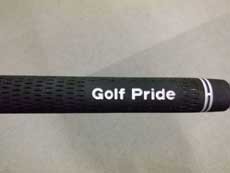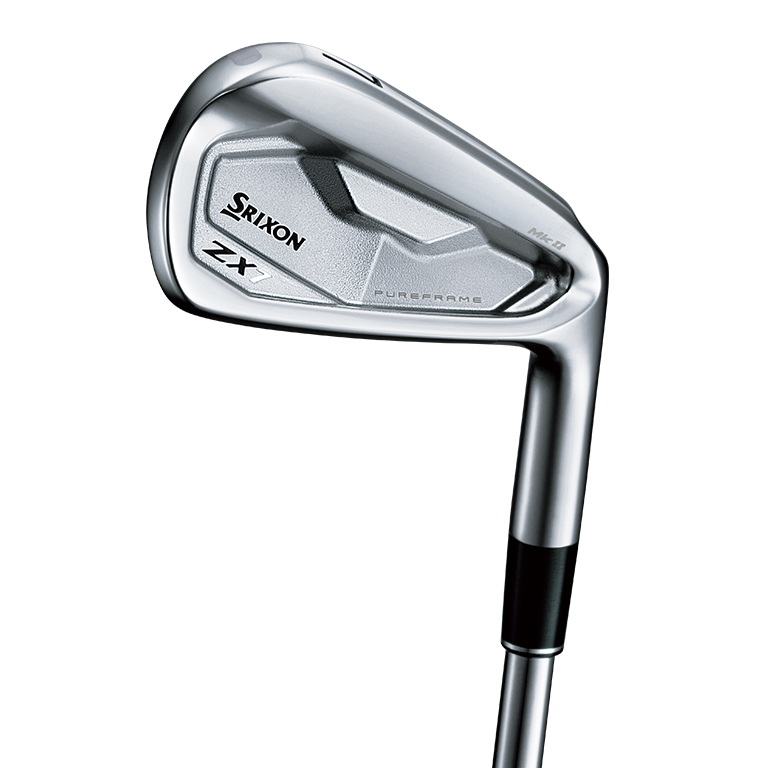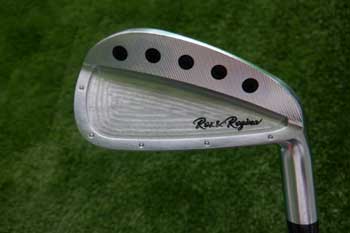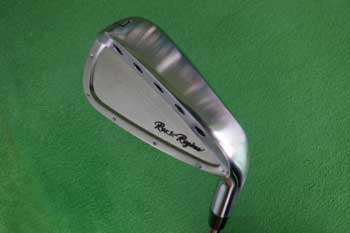Test Review of the DUNLOP SRIXON ZX7 Mk II Irons

Today, I had the chance to test this golf club.
The club I tested is the 7-iron of the Dunlop Srixon ZX7 Mk II Irons.

The shaft is N.S.PRO MODUS3 TOUR120.
The loft is 32°, the club length is 36.75 inches, the shaft flex is S, the shaft weight is 105g, torque is 1.7, and the kick point is middle/low.

This is a very cool-looking new Srixon iron.
At first glance, I couldn’t resist picking it up.
While focusing on ease of use with a cavity design, it also emphasizes aesthetics and feel, making for a flawless design.

On the heel side, it says “PUREFRAME” in small letters.
Pure frame…
What does that mean?

It has a traditional shape.
A very cool Srixon iron, I had a great visual experience.
It has the feel of soft iron, and the impression is that it looks very soft just by looking at it.
This iron is considered an “athlete model,” but it doesn’t seem to have a particularly high face.
Has the face become a little shallower?
These types of designs are becoming more common now, and just like with drivers, deep faces are becoming less frequent.

The cavity is neither too shallow nor too deep, it’s a standard cavity design.
It has three tiers, with thick areas where necessary, and a highly calculated design.

The top line thickness is standard.
It is not thin.

The sole width is also standard.
It’s neither narrow nor wide.
It has a “catching” sole shape, I thought.
What I mean by that is, the sole is not completely flat; it curves, giving it an image of being more forgiving.
The “face” of the iron when set up is different from the usual “face” you would see.
The back face of a golf club has various faces.

The sole is split in two sections.
It’s a design commonly seen in Srixon clubs.
I would call it a “smooth” sole design, which makes the club glide through the turf easily.
I once tried a similar sole design on a course, and it exceeded expectations with how smoothly it glided, greatly reducing the resistance from the grass.

The neck is not long, but standard, though it appears a bit shorter.

The face features a unique milling pattern.
It’s the same milling I tried on the utility club recently.
What kind of effects can we expect from this milling?

The grip installed is the Tour Velvet, which is excellent.
I’ve tried various grips, but I always come back to this one.
It may not be the most durable, but it has a great feel, and even when it’s a bit wet on rainy days, it revives quickly with just a towel wipe.
It feels great even when a little damp, but the best feel comes when it’s dry.

I was able to quickly find my timing after swinging it a few times.
Recently, Modus shafts have become popular, and many of my friends are using them.
The craftsman I usually rely on strongly recommends these shafts, but I’d like to try them out after using DG shafts a bit more.
I’ve used DG shafts since I started golf, so they give me a strong sense of security, but I’ve felt the high performance of Modus through testing.

It feels amazing at setup.
I was ready to address the ball in an instant.
For irons that are hard to set up, it takes a little longer, but it was immediate with this one.
I believe the ease of setup, or the speed at which you can address the ball, is part of a club’s performance, and this iron has a very high score in that regard.
Of course, large size and strong offsets may be harder for some to set up, and preferences vary, but I really like this one.
It has a bold, sharp look, but it doesn’t feel too aggressive.
In fact, it has a softness that gives it a more approachable feel.
As I thought about it, I realized that good clubs tend to stimulate positive thoughts in your head.
Test Begin

From the first ball, I couldn’t help but smile at the fantastic feel.
It makes you smile.
It has the feel of soft iron, and I expected a good feel, but it exceeded my expectations.
The feel of irons can be affected by whether they are hollow or not, and the back face design plays a big role, but even with the soft iron cavity, it varies from brand to brand…
Of course, this iron falls into the “Ping” category, delivering top-level feel.
With this feel, even players who typically use muscle backs would appreciate this cavity design and may rethink their preference for muscle back irons.
It doesn’t have the “thin” feel typical of cavities, and instead, it has a moderate thickness, giving the sensation of carrying the ball.

The ball flight is standard, and there isn’t a special effort to make it launch easily.
However, the sole slides smoothly, and I felt that the ball hitting height (strike point) became more consistent, making it easier to launch and stabilizing the height.
This is a big difference from older irons.
Older irons didn’t pay as much attention to sole design.
Also, the moderate low center of gravity is probably one of the reasons it’s so well-liked.

This is a very cool-looking iron, and some may think it looks tough, but that’s not the case, and I’d love for many to try it out.
It gives players the ease of a normal cavity design.
If you only want a large full cavity design, it may not suit you, but for those who like the size, it’s a very easy-to-use iron that acts almost like an extension of your hands.
It’s cool but not overly complicated, making it a “best of both worlds” iron.

The “distance performance” is about average for today’s irons.
It’s not a distance iron, but many athlete models today are more distance-friendly, and this iron follows that trend.
If you want to prioritize vertical distance but still want a bit more distance, this is the right iron for you.
I’d call it a “slightly longer” iron.
In my feel, it’s about one club longer than usual.

The “playability” is excellent, and it responds well to both fades and draws.
It’s an all-around iron that’s easy for both draw and fade hitters to handle.
It’s easy to set up and creates a good image in your head, and since it has great ball control, it naturally enhances playability.
Recently, we’ve seen more “springy” irons, but an iron like this one with a “controlled” feel is definitely appealing.
Post-Test Impressions

True to Srixon’s reputation, this is a well-balanced iron with a high level of performance.
I couldn’t find any major flaws, only good points.

As I mentioned earlier, it’s a cool-looking iron, but it’s not difficult to use, which adds to its charm.
Recently, more irons with a mix of “cool” and “easy to use” have appeared.
I think this is due to the improvement in manufacturers’ technologies.

Creating an iron that is “physically” easy to use is easy enough.
If you don’t care about the look…
It may be fine if a machine is hitting it, but the reality is, it’s humans hitting the clubs.
Humans have a “sensibility” that machines do not possess.
This sensibility is innate, and the more experience you gain, the more refined it becomes.
Humans are always evolving.
I’ve encountered clubs that seem to ignore this sensibility, but as expected, Dunlop doesn’t.
Dunlop always prioritizes human sensibility, and testing this iron today reminded me of that again.

This is just my opinion, but if you want to improve, you shouldn’t rely too much on your clubs, but rather focus on refining your own sensibility.
The earlier you start, the better.
It’s like “strike while the iron is hot.”
As beginners, many might think that bigger heads and wide sweet spots are better, and lighter, softer shafts are better, but I don’t think that’s the case.
Even beginners can use soft iron with no problem, and if they have power, it’s not a bad idea to use a heavier, firmer shaft.
As I’ve said before, overly light or soft shafts can be difficult to handle.
Even with limited experience, players with power often find that a more substantial, heavier club is easier to control.
Especially for beginners, they may not be sensitive to weight or stiffness, so they may easily get used to a club and think “this is just how it is.”
Even with a weighty shaft, they might not feel it’s heavy.
By having a personal reference and standard, it becomes easier to understand the differences between clubs, and once you
find the right match, you’ll feel less concerned about new products when they come out.
You’ll know your own club is better…

Considering all of this, I feel that this iron is a great partner to add to your bag.
It looks great, and with the Srixon brand image, it satisfies your desire to own it.
Taking it out of your bag and hitting the ball will bring joy.
Unless you specifically prefer oversized, strong offset irons made of stainless steel, this iron is definitely an attractive option.

Though most golf clubs are made overseas, the fact that this iron is made in Japan adds to its appeal.
Of course, there are many great clubs made overseas, but Japanese-made clubs come with enhanced reliability and are highly regarded.
In fact, many large, well-known brands don’t offer as many Japanese-made clubs.
Considering all this, this is an iron that you’ll want to keep in your bag for a long time.
☆
Ease of setup…☆☆☆☆☆
Feel…☆☆☆☆☆
Launch ease…☆☆☆
Stability…☆☆☆
Distance performance…☆☆☆☆
Playability…☆☆☆☆☆
※(100 points scale)
☆1 = 0–20 points
☆2 = 21–40 points
☆3 = 41–60 points
☆4 = 61–90 points
☆5 = 91–100 points
*Addition: Introduction to this club (I researched this club after writing this article)
Srixon ZX7 Mk II Irons: In-Depth Review
Introduction
The Srixon ZX7 Mk II irons are designed for discerning golfers seeking a blend of traditional craftsmanship and modern performance. Building upon the success of their predecessor, the ZX7 Mk II irons aim to deliver enhanced feel, control, and consistency. This review delves into their specifications, features, performance, and suitability for various golfers.
Specifications
| Club | Loft | Lie Angle | Length | Offset | Bounce |
|---|---|---|---|---|---|
| 4-iron | 22° | 60.5° | 38.5″ | 3.3 mm | 2.8° |
| 5-iron | 25° | 61° | 38″ | 3.2 mm | 2.6° |
| 6-iron | 28° | 61.5° | 37.5″ | 3.0 mm | 2.4° |
| 7-iron | 32° | 62° | 37″ | 2.8 mm | 2.2° |
| 8-iron | 36° | 62.5° | 36.5″ | 2.4 mm | 2.0° |
| 9-iron | 41° | 63° | 36″ | 2.0 mm | 1.8° |
| PW | 46° | 63.5° | 35.5″ | 1.7 mm | 1.6° |
Note: Specifications are based on standard configurations and may vary with custom fittings.Plugged In Golf+18us.dunlopsports.com+18eu.dunlopsports.com+18
Features
1. PUREFRAME Technology
The ZX7 Mk II irons incorporate Srixon’s PUREFRAME technology, which involves an 80% thicker portion of 1020 carbon steel forged into the body just behind the sweet spot. This design enhances feel at impact by reducing unwanted vibrations, providing a remarkably soft yet solid strike without sacrificing workability. Golfer Geeks+5us.dunlopsports.com+5eu.dunlopsports.com+5Golf Monthly+5eu.dunlopsports.com+5us.dunlopsports.com+5
2. Tour V.T. Sole
The Tour V.T. sole features a higher bounce on the leading edge to prevent digging and a lower bounce on the trailing edge to facilitate smooth turf interaction. This design ensures clean strikes across various lies, contributing to consistent performance. us.dunlopsports.com+7eu.dunlopsports.com+7Golf Monthly+7
3. Progressive Grooves
The ZX7 Mk II irons utilize progressive grooves, with wider grooves in the 3-7 irons for longer shots and deeper, closer-set grooves in the 8-AW for enhanced spin control. Laser milling between each groove increases friction, ensuring consistent spin and launch conditions across the set. eu.dunlopsports.com+1
4. Shaft Options
Standard shaft offerings include the Nippon N.S. Pro Modus3 Tour 120 steel shaft, known for its high tip rigidity that steadies impact and minimizes unwanted spin, while its less rigid mid and butt sections improve tempo and provide a smooth, comfortable impact feel. us.dunlopsports.com+1
Performance
1. Feel and Feedback
The incorporation of PUREFRAME technology results in a soft yet solid feel at impact, with minimal harshness. The feedback is crisp, allowing players to discern the quality of their strikes. Golf Monthly+5us.dunlopsports.com+5us.dunlopsports.com+5
2. Distance and Forgiveness
While the ZX7 Mk II irons are designed for precision, they offer ample distance and forgiveness for their category. Players have reported consistent carry distances and reliable performance, even on slight mishits. Golf Monthly+5GolfWRX+5Plugged In Golf+5srixonasia.com+5Golfer Geeks+5Golf Monthly+5
3. Workability
The compact shape and refined sole design facilitate shot shaping, making it easier for skilled players to work the ball as desired. The irons provide the versatility needed for various course conditions. us.dunlopsports.com+6Golf Monthly+6us.dunlopsports.com+6GolfWRX
Ideal Player Profile
The Srixon ZX7 Mk II irons are best suited for low to mid-handicap golfers who prioritize feel, control, and workability. Players with consistent ball-striking abilities will benefit most from these irons. High-handicap golfers may find the ZX5 Mk II irons more forgiving and easier to launch.Golf Monthly+4Golf Monthly+4Golf Monthly+4Golf Monthly
Pros and Cons
Pros:
Enhanced feel and feedback
Consistent distance and forgivenessGolf Monthly
Excellent workabilityus.dunlopsports.com+3Golf Monthly+3eu.dunlopsports.com+3
Premium aestheticsGolf Monthly
Cons:
May not be as forgiving on off-center hits for higher handicaps
Requires consistent ball-striking for optimal performanceus.dunlopsports.com+9Golf Monthly+9Golf Monthly+9
Conclusion
The Srixon ZX7 Mk II irons offer a compelling combination of traditional craftsmanship and modern performance features. With their enhanced feel, consistent performance, and workability, they cater to golfers seeking precision and control. While they may not be the most forgiving option for higher handicaps, they provide exceptional value for skilled players looking to elevate their game.Golf Monthly+1
Note: All information is based on official specifications and reputable reviews available as of 2025.
Want to read the original article in Japanese? Click here











